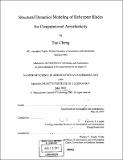| dc.contributor.advisor | Carlos E.S. Cesnik. | en_US |
| dc.contributor.author | Cheng, Tao, 1975- | en_US |
| dc.contributor.other | Massachusetts Institute of Technology. Dept. of Aeronautics and Astronautics. | en_US |
| dc.date.accessioned | 2007-05-16T18:58:46Z | |
| dc.date.available | 2007-05-16T18:58:46Z | |
| dc.date.copyright | 2002 | en_US |
| dc.date.issued | 2002 | en_US |
| dc.identifier.uri | http://hdl.handle.net/1721.1/37563 | |
| dc.description | Thesis (S.M.)--Massachusetts Institute of Technology, Dept. of Aeronautics and Astronautics, 2002. | en_US |
| dc.description | Page 180 blank. | en_US |
| dc.description | Includes bibliographical references (p. 177-179). | en_US |
| dc.description.abstract | This thesis deals with structural dynamics modeling and simulation in time domain of helicopter blades for computational aeroelasticity. A structural model and an aeroelastic model are provided and a computer program has been developed and tested in this research. In the structural model, second-order backward Euler method is used to discretize the nonlinear intrinsic formulation for the dynamics of rotating blades in time. Newton method is used to solve the resulting nonlinear algebraic equations. The solution describes the displacement field, stress and strain field at each time step of twist composite hingeless or articulated rotor blades under the action of arbitrary external loads. Results are validated by experimental data and other numerical simulation work for various conditions. Then the aerodynamic model implemented via the GENUVP code is integrated with the structural model to form an aeroelastic simulation. The aeroelastic analysis is realized in time domain by exchanging information with two interfaces and performing consecutive aerodynamic and structural time steps. In the aeroelastic analysis, the steady state of a fixed wing at different flight speeds have been obtained and results are consistent with other methods. The time response of the active twist rotor (ATR) prototype blade in hover has also been examined. The twist response of ATR blade due to applied piezoelectric actuation is obtained and the result compared with published results. A good qualitative agreement between the present aeroelastic solution and reference results was obtained. However, quantitative discrepancies were encountered that strongly suggest that further improvements on the coupling between the two codes are needed. For all the aeroelastic test cases using the GENUVP code, no sub-iterations within a time step was used. A study considering a simple quasi-steady aerodynamics indicated that a sub-iteration in each time step may be critical to the accuracy of the final aeroelastic result. Recommendations for further work is provided at the end. | en_US |
| dc.description.statementofresponsibility | by Tao Cheng. | en_US |
| dc.format.extent | 180 p. | en_US |
| dc.language.iso | eng | en_US |
| dc.publisher | Massachusetts Institute of Technology | en_US |
| dc.rights | M.I.T. theses are protected by copyright. They may be viewed from this source for any purpose, but reproduction or distribution in any format is prohibited without written permission. See provided URL for inquiries about permission. | en_US |
| dc.rights.uri | http://dspace.mit.edu/handle/1721.1/7582 | |
| dc.subject | Aeronautics and Astronautics. | en_US |
| dc.title | Structural dynamics modeling of helicopter blades for computational aeroelasticity | en_US |
| dc.type | Thesis | en_US |
| dc.description.degree | S.M. | en_US |
| dc.contributor.department | Massachusetts Institute of Technology. Department of Aeronautics and Astronautics | |
| dc.identifier.oclc | 51687496 | en_US |
